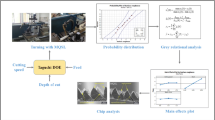Abstract
Green manufacturing is one of the important development directions for advanced manufacturing technology. In this paper, the orthogonal turning experiment of multiple factors with the minimal quantity lubrication (MQL), dry machining, and wet machining is designed to contrast the machinability for austenitic stainless steel in order to realize environmentally friendly machining with high efficiency, excellent surface quality, energy conservation, and little consumption for austenitic stainless steel. On the basis of the experiment results, in which the conditions of MQL or dry machining instead of wet machining are given, the optimized principle of process parameters for high surface quality and environmentally friendly machining austenitic stainless steel with high machining efficiency and little energy consumption is found and proposed by the comprehensive evaluation of the integrated mechanism of the process parameters with relative cutting-specific energy, unit cutting force, surface roughness, and process condition of MQL and dry machining. The research conclusions have theoretical and practical importance for production and process to give the relevant optimized principle of process parameters for machined hardening stainless steels by studying the integrated mechanism of the process parameters especially on the basis of the orthogonal experiment of multiple factors with little experiment consumption and cost.
Similar content being viewed by others
References
Klocke F, Eisenblatter G (1997) “Dry cutting”. CIRP Ann 46:2519–526
Vieira JM, Machado AR, Ezugwu EO (2001) Performance of cutting fluids during face milling of steels. J Mater Process Tech 116(2–3):244–251
Fratila D (2009) Evaluation of near-dry machining effects on gear milling process efficiency. J Clean Prod 17(9):839–845
Weinert K, Sutherland JW, Wakabayashi T (2004) Dry machining and minimum quantity lubrication. CIRP Ann Manufact Technol 53(2):511–537
Fratila D, Caiza C (2011) Application of Taguchi method to selection of optimal lubrication and cutting conditions in face milling of AlMg3. J Clean Prod 19:640–645
Hadad M, Sadeghi B (2013) Minimum quantity lubrication-MQL turning of AISI 4140 steel alloy. J Clean Prod 54:332–343
Lawal SA, Choudhury IA, Nukman Y (2012) A critical assessment of lubrication techniques in machining processes: a case for minimum quantity lubrication using vegetable oil-based lubricant. J Clean Prod 41:210–221
Fukui H, Okida J, Omori N, Moriguchi H, Tsuda K (2004) Cutting performance of DLC coated tools in dry machining aluminum alloys. Surf Coat Technol 187:70–76
Dhar NR, Islam MW, Islam S, Mithu MAH (2006) The influence of minimum quantity of lubrication (MQL) on cutting temperature, chip and dimensional accuracy in turning AISI-1040 steel. J Mater Process Tech 171(1):93–99
Sayuti M, Sarhan AD, Faheem S (2014) Novel uses of SiO2 nano-lubrication system in hard turning process of hardened steel AISI4140 for less tool wear, surface roughness and oil consumption. J Clean Prod 67:265–276
Helu M, Behmann B, Meier H, Dornfeld D, Lanza G, Schulze V (2012) Impact of green machining strategies on achieved surface quality. CIRP Ann-Manuf Technol 61:55–58
Huang PL, Li JF, Sun J, Zhou J (2014) Study on performance in dry milling aeronautical titanium alloy thin-wall components with two types of tools. J Clean Prod 67:258–264
Devillez A, Coz GL, Dominiak S, Dudzinski D (2011) Dry machining of Inconel 718, workpiece surface integrity. J Mater Process Tech 211:1590–1598
Fernández-Abia AI, Barreiro J, López de Lacalle LN, Martínez (2011) Effect of very high cutting speeds on shearing, cutting forces and roughness in dry turning of austenitic stainless steels. Int J Adv Manuf Technol 57:61–71
Haron CHC, Ginting A, Arshad H (2007) Performance of alloyed uncoated and CVD- coated carbide tools in dry milling of titanium alloy Ti-6242S. J Mater Process Technol 185:77–82
Koné F, Czarnota C, Haddag B, Nouari M (2013) Modeling of velocity-dependent chip flow angle and experimental analysis when machining 304L austenitic stainless steel with groove coated-carbide tools. J Mater Process Technol 213(7):1166–1178
Martin M, Weber S, Izawa C, Wagner S, Pundt A, Theisen W (2011) Influence of machining-induced martensite on hydrogen-assisted fracture of AISI type 304 austenitic stainless steel. Int J Hydrog Energy 36(17):11195–11206
Ghosh S, Rana V, Kain V, Swati M, Baveja S (2011) Role of residual stresses induced by industrial fabrication on stress corrosion cracking susceptibility of austenitic stainless steel. Mater Des 32(7):3823–3831
Deng J, Zhou J, Zhang H, Yan P (2011) Wear mechanisms of cemented carbide tools in dry cutting of precipitation hardening semi-austenitic stainless steels. Wear 270(78):520–527
Ghosh S, Kain V (2010) Microstructural changes in AISI 304L stainless steel due to surface machining: effect on its susceptibility to chloride stress corrosion cracking. J Nucl Mater 403(1-3):62–67
Author information
Authors and Affiliations
Corresponding author
Rights and permissions
About this article
Cite this article
Zhang, Y., Zou, P., Li, B. et al. Study on optimized principles of process parameters for environmentally friendly machining austenitic stainless steel with high efficiency and little energy consumption. Int J Adv Manuf Technol 79, 89–99 (2015). https://doi.org/10.1007/s00170-014-6763-x
Received:
Accepted:
Published:
Issue Date:
DOI: https://doi.org/10.1007/s00170-014-6763-x



